QUESS
EO
Operational (nominal)
Data collection
CAS
Quick facts
Overview
| Mission type | EO |
| Agency | CAS |
| Mission status | Operational (nominal) |
| Launch date | 15 Aug 2016 |
| Instrument type | Data collection |
| CEOS EO Handbook | See QUESS summary |
QUESS (Quantum Experiments at Space Scale) / Micius
Spacecraft Launch Mission Status Experiment complement Ground Segment References
QUESS is a joint Chinese-Austrian satellite mission operated by CAS (Chinese Academy of Sciences), in cooperation with the University of Vienna and the Austrian Academy of Sciences (AAS). QUESS is a proof-of-concept mission designed to facilitate quantum optics experiments over long distances to allow the development of quantum encryption and quantum teleportation technology.
The Quantum Science Satellite (QSS), also known as the Quantum Experiments at Space Scale (QUESS), was nicknamed “Micius” after a fifth century B.C. Chinese scientist named Mozi (Micius in Latin). He discovered that light travels in straight lines and was likely the first person to record an image with a pinhole.
The scientific objectives of the QUESS mission are:
• Implementation of long-distance quantum communication network based on high-speed QKD (Quantum Key Distribution) between the satellite and the ground station, to achieve major breakthroughs in the realization of spaceborne practical quantum communication.
• Quantum entanglement distribution and quantum teleportation on a space scale, fundamental tests of the laws of quantum mechanics on a global scale.
Quantum entanglement is a physical phenomenon in which pairs or groups of particles interact in ways such that the quantum state can only be described for the system as a whole and not for the individual particles part of that system. The measurement of a property of a particle can be seen as acting on that particle and will change its original quantum property which – in case of entangled particles – will cause the system’s quantum state to change. It appears that one particle of an entangled pair “knows” the measurement conducted on the other particle in an exchange of information that can cover any distance.
Background
The Institute for Quantum Optics and Quantum Information (IQOQI), Vienna, Austria, is conducting a collaboration project with the University of Science and Technology of the Chinese Academy of Science (CAS). Within this project, CAS will launch a dedicated quantum science satellite to facilitate quantum optics experiments from space to ground. IQOQI will provide optical ground stations in Europe for receiving the quantum signal sent from the Chinese satellite. The scientific goal within this cooperation is to intercontinentally generate an unconditional secure quantum cryptographic key between two earth based stations in Asia and Europe, respectively. The Chinese mission “XD-2: Quantum Experiments at Space Scale (QUESS)” is managed directly under a CAS contract. 1)
The partnership contract between CAS and the Austrian Academy of Sciences was signed in 2011. 2)
The mission, first proposed by Jianwei Pan (PI) of CAS in 2003, is an early experiment in the extremely demanding nascent field of quantum communication.
Quantum communications are secure because any tinkering with them is detectable. Two parties can communicate secretly — by sharing an encryption key encoded in the polarization of a string of photons, say — safe in the knowledge that any eavesdropping would leave its mark.
So far, scientists have managed to demonstrate quantum communication up to about 300 km. Photons travelling through optical fibers and the air get scattered or absorbed, and amplifying a signal while preserving a photon’s fragile quantum state is extremely difficult. The Chinese researchers hope that transmitting photons through space, where they travel more smoothly, will allow them to communicate over greater distances.
At the heart of their satellite is a crystal that produces pairs of entangled photons, whose properties remain entwined however far apart they are separated. The craft’s first task will be to fire the partners in these pairs to ground -stations in Beijing and Vienna, and use them to generate a secret key.
During the two-year mission, the team also plans to perform a statistical measurement known as a Bell test to prove that entanglement can exist between particles separated by a distance of 1,200 km. Although quantum theory predicts that entanglement persists at any distance, a Bell test would prove it.
The team will also attempt to ‘teleport’ quantum states, using an entangled pair of photons alongside information transmitted by more conventional means to reconstruct the quantum state of a photon in a new location (Ref. 4).
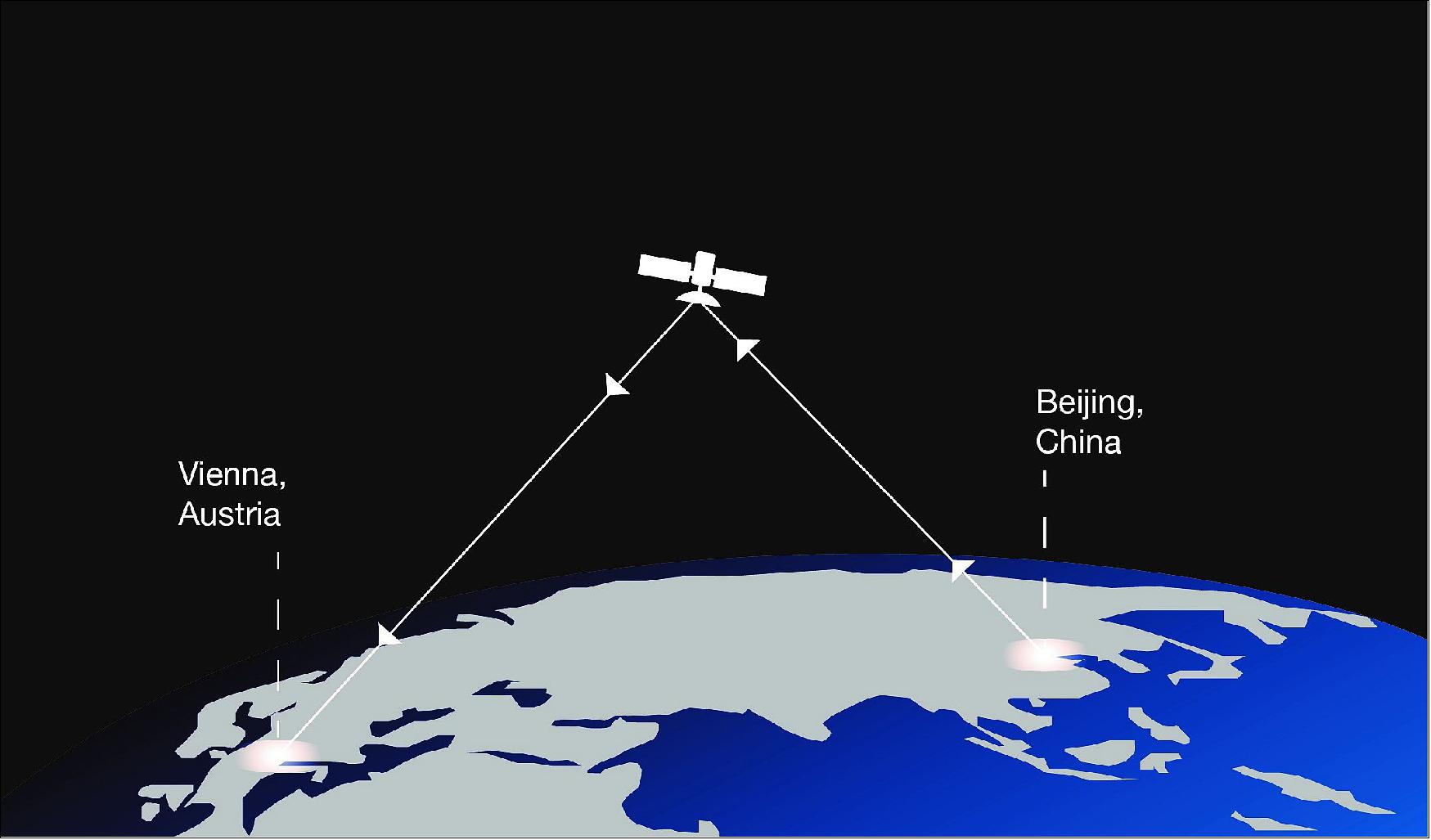
Spacecraft
Built by NSSC (National Space Science Center) of CAS, the Micius satellite has a mass of ~640 kg. QUESS is based on a minisatellite bus that can host payloads of around 200 kg, providing a stable platform with precise pointing capability for ground stations to lock onto the optical carriers from the satellite and vice versa. It is fitted with two deployable solar arrays and is designed to be operational for up to two years. The spacecraft is equipped with a quantum key communicator, a quantum entanglement emitter, a quantum entanglement source, a quantum experiment controller and processor, and a high-speed coherent laser communicator.
The communications data from the QUESS satellite is received by three ground receiving stations located at Miyun (Beijing), Sanya (Hainan), and Kashgar (Xinjiang), and processed by the NSSC (National Space Science Center) of CAS (China Academy of Sciences) in Beijing.
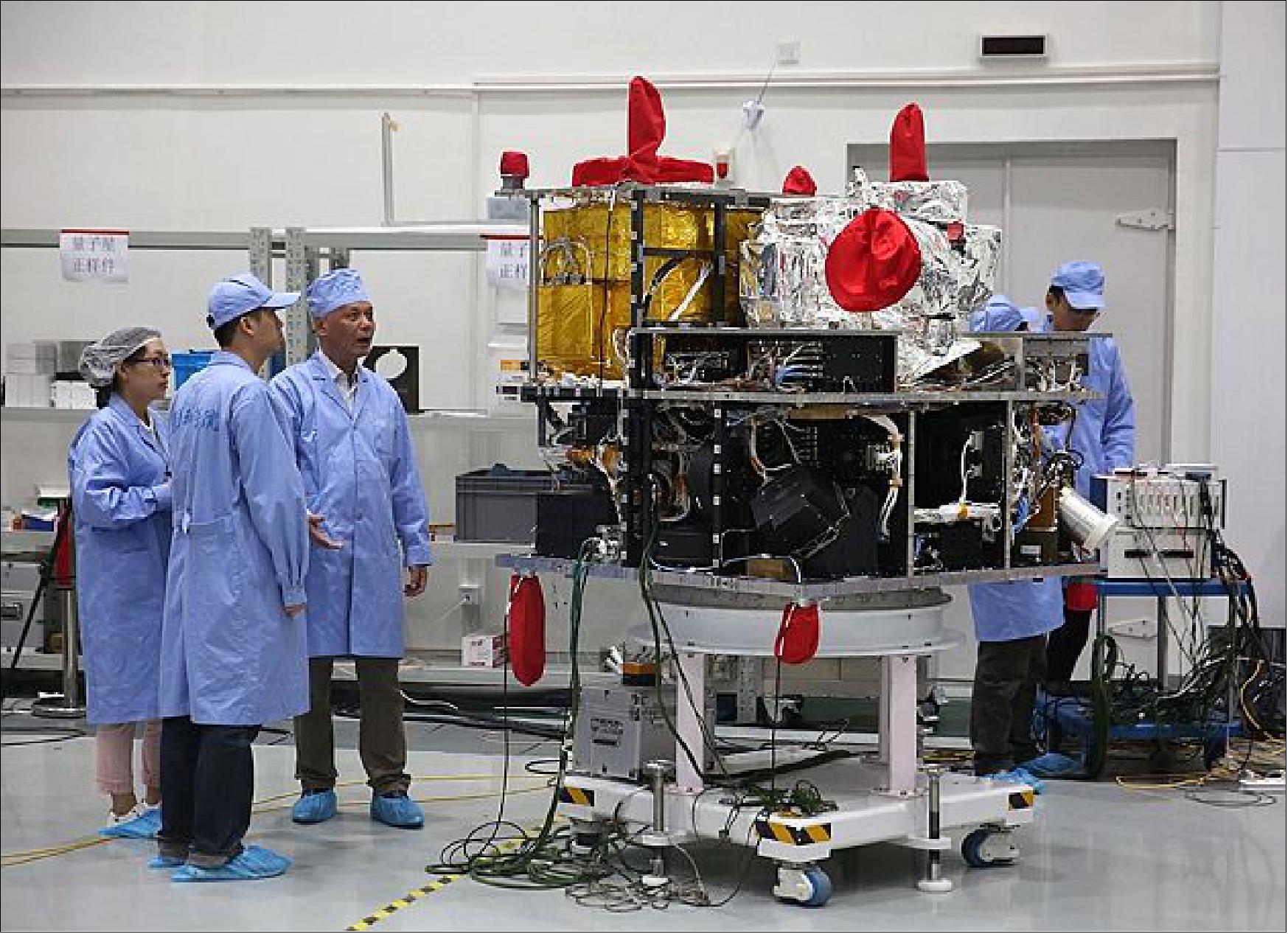
Launch
The QUESS spacecraft was launched on August 15, 2016 (17:40:04 UTC)on a Long March 2D (CZ-2D) vehicle from JSLC (Jiuquan Satellite Launch Center) in the Gobi Desert of China. 5) 6) 7)
Orbit: Sun-synchronous orbit, altitude of about 500 km, inclination = 97.37°.
The secondary payloads on this flight were:
• Lixing-1, a microsatellite (110 kg) of CAS, developed by NSSC (National Space Science Center). Lixing-1 will operate at a very low orbital altitude of between 100-150 km to study this region of extremely thin atmosphere.
• 3Cat-2, a 6U CubeSat developed by the NanoSat Lab of UPC (Polytechnic University of Catalonia), Spain with a mass of 7.1 kg.
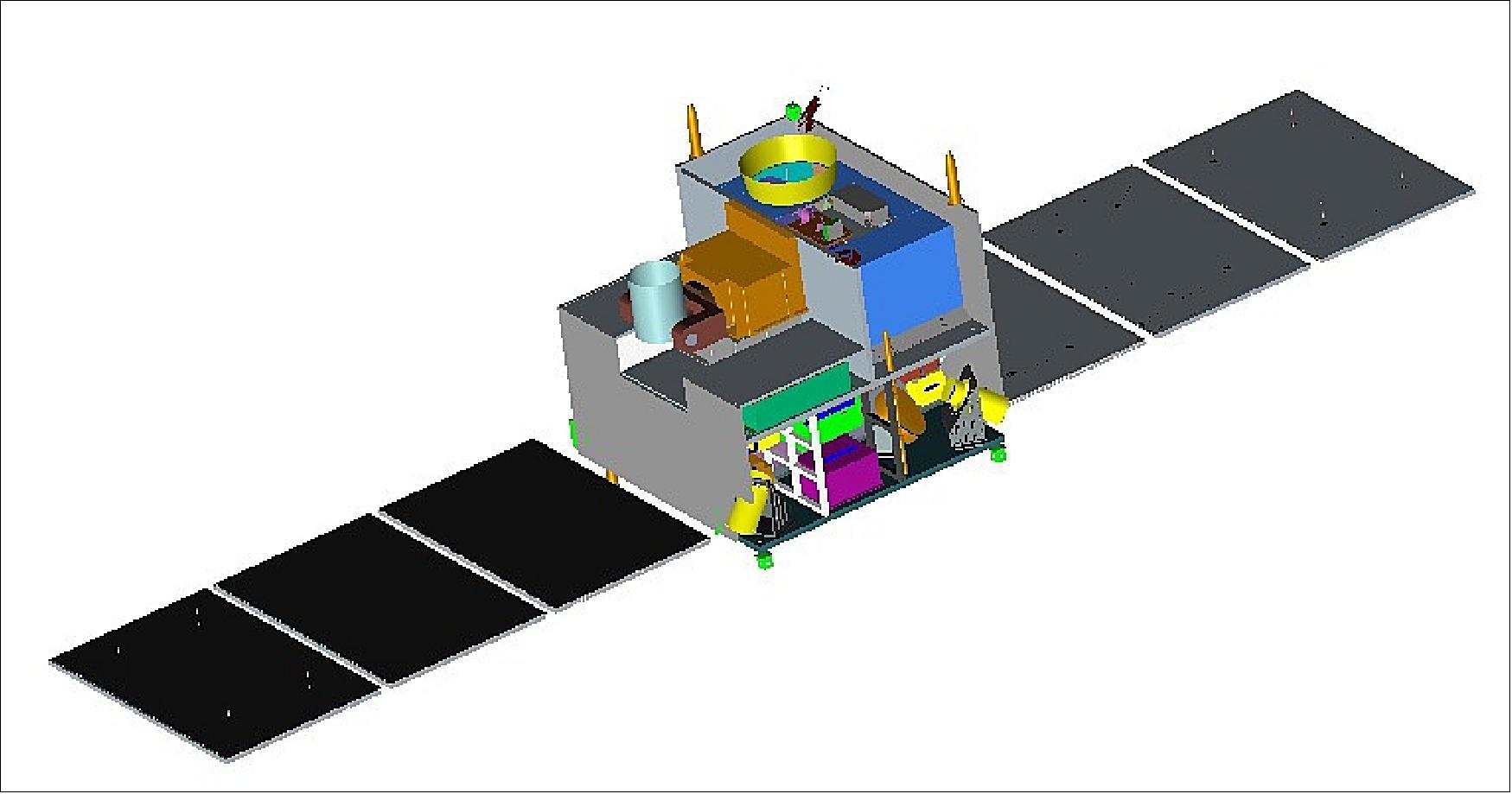
Mission Status
• January 6, 2021: Chinese scientists have established the world's first integrated quantum communication network, combining over 700 optical fibers on the ground with two ground-to-satellite links to achieve quantum key distribution over a total distance of 4,600 kilometers for users across the country. The team, led by Jianwei Pan, Yuao Chen, Chengzhi Peng from the University of Science and Technology of China in Hefei, reported in Nature their latest advances towards the global, practical application of such a network for future communications. 8) 9)
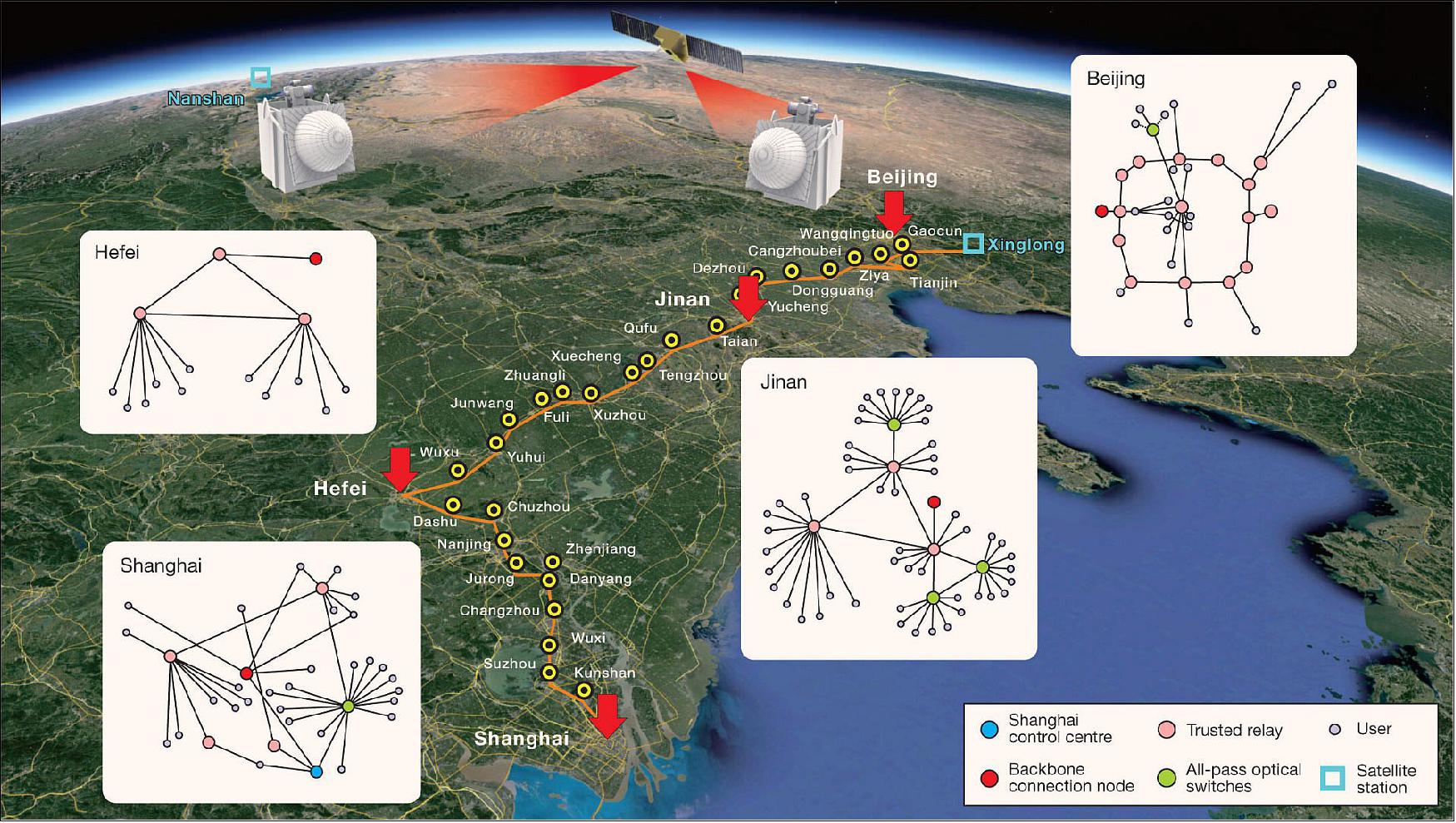
- Unlike conventional encryption, quantum communication is considered unhackable and therefore the future of secure information transfer for banks, power grids and other sectors. The core of quantum communication is quantum key distribution (QKD), which uses the quantum states of particles—e.g. photons—to form a string of zeros and ones, while any eavesdropping between the sender and the receiver will change this string or key and be noticed immediately. So far, the most common QKD technology uses optical fibers for transmissions over several hundred kilometers, with high stability but considerable channel loss. Another major QKD technology uses the free space between satellites and ground stations for thousand-kilometer-level transmissions. In 2016, China launched the world's first quantum communication satellite (QUESS, or Mozi/Micius) and achieved QKD with two ground stations which are 2,600 km apart. In 2017, an over 2,000-km long optical fiber network was completed for QKD between Beijing and Shanghai.
- Using trusted relays, the ground-based fiber network and the satellite-to-ground links were integrated to serve more than 150 industrial users across China, including state and local banks, municipal power grids, and e-government websites. This work shows that quantum communication technology can be used for future large-scale practical applications. Similarly, a global quantum communication network can be established if national quantum networks from different countries are combined, and if universities, institutions and companies come together to standardize related protocols, hardware.
- In the last couple of years, the team extensively tested and improved the performance of different parts of the integrated network. For instance, with an increased clock rate and more efficient QKD protocol, the satellite-to-ground QKD now has an average key generation rate of 47.8 kilobits per second, which is 40 times higher than the previous rate. The researchers have also pushed the record for ground-based QKD to beyond 500 km using a new technology called twin-field QKD (TF-QKD).
- Next up, the team will further expand the network in China and with their international partners from Austria, Italy, Russia and Canada. They also aim to develop small-scale, cost-efficient QKD satellites and ground-based receivers, as well as medium and high earth orbit satellites to achieve all-time, ten-thousand-km-level QKD.
• May-June 2018: The QUESS operation is smooth, the project received a lot of experience from the mission. In particular, the experience is significant with regard to the success of the science mission. Adequate preparation before the satellite launch is very important, including the system, the organization, the training, the mission practice, the critical event discussions and decisions, etc. Most important, full communication and united cooperation are the basis for success (Ref. 23).
• January 19, 2018: A joint China-Austria team has performed quantum key distribution between the quantum-science satellite Micius and multiple ground stations located in Xinglong (near Beijing), Nanshan (near Urumqi), and Graz (near Vienna). Such experiments demonstrate the secure satellite-to-ground exchange of cryptographic keys during the passage of the satellite Micius over a ground station. Using Micius as a trusted relay, a secret key was created between China and Europe at locations separated up to 7,600 km on the Earth. 10)
- Private and secure communications are fundamental for Internet use and e-commerce, and it is important to establish a secure network with global protection of data. Traditional public key cryptography usually relies on the computational intractability of certain mathematical functions. In contrast, quantum key distribution (QKD) uses individual light quanta (single photons) in quantum superposition states to guarantee unconditional security between distant parties. Previously, the quantum communication distance has been limited to a few hundred kilometers due to optical channel losses of fibers or terrestrial free space. A promising solution to this problem exploits satellite and space-based links, which can conveniently connect two remote points on the Earth with greatly reduced channel loss, as most of the photons' propagation path is through empty space with negligible loss and decoherence.
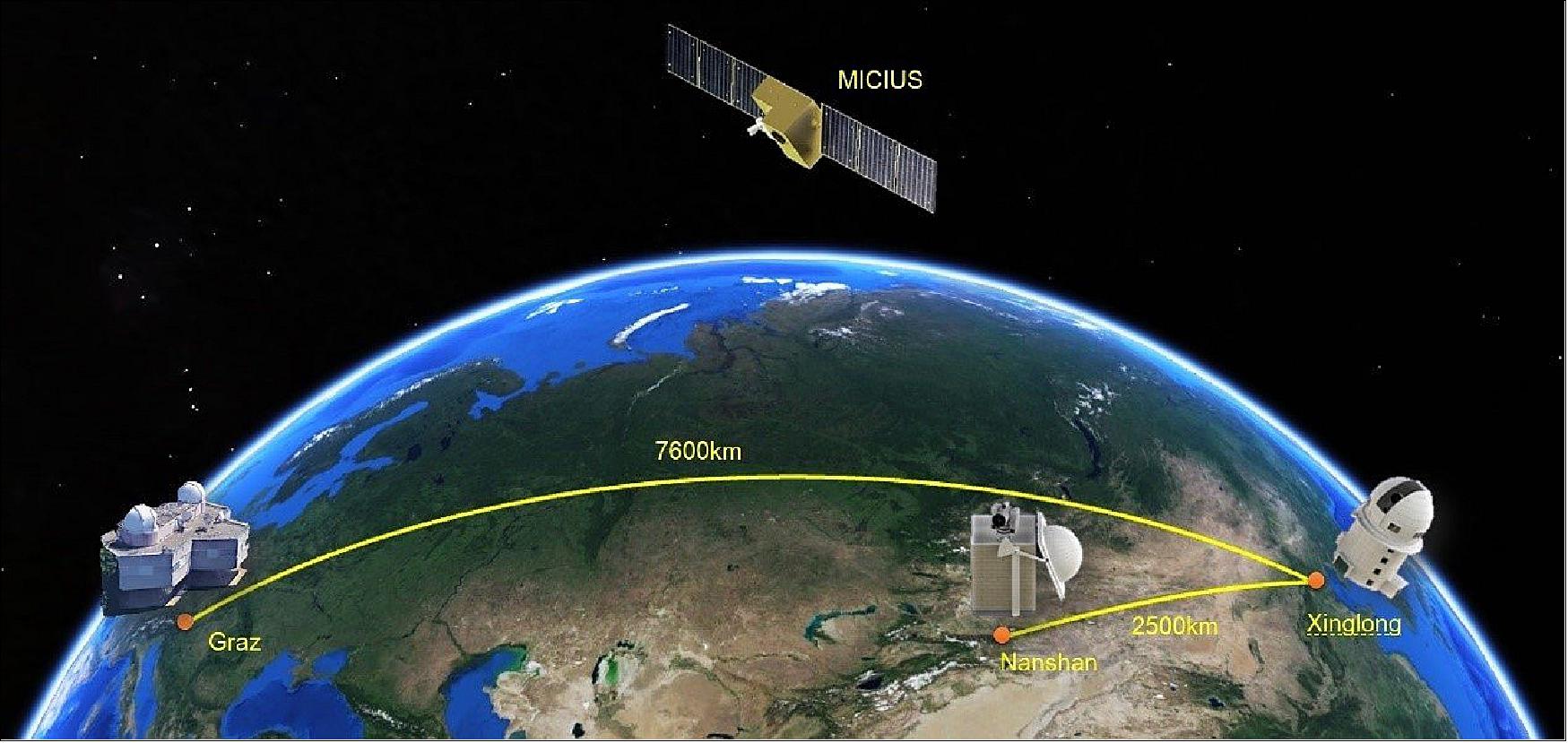
- A cross-disciplinary multi-institutional team of scientists from the Chinese Academy of Sciences, led by Professor Jian-Wei Pan, has spent more than 10 years developing a sophisticated satellite, Micius, dedicated to quantum science experiments, which was launched on August 2016 and orbits at an altitude of ~500 km. Five ground stations in China coordinate with the Micius satellite. These are located in Xinglong (near Beijing), Nanshan (near Urumqi), Delingha (37°22'44.43''N, 97°43'37.01"E), Lijiang (26°41'38.15''N, 100°1'45.55''E), and Ngari in Tibet (32°19'30.07''N, 80°1'34.18''E).
- Within a year after launch, three key milestones for a global-scale quantum internet were achieved: satellite-to-ground decoy-state QKD with kHz rate over a distance of ~1200 km (Liao et al. 2017, Nature 549, 43); satellite-based entanglement distribution to two locations on the Earth separated by ~1200 km and Bell test (Yin et al. 2017, Science 356, 1140), and ground-to-satellite quantum teleportation (Ren et al. 2017, Nature 549, 70). The effective link efficiencies in the satellite-based QKD were measured to be ~20 orders of magnitude larger than direct transmission through optical fibers at the same length of 1200 km. The three experiments are the first steps toward a global space-based quantum internet.
- The satellite-based QKD has now been combined with metropolitan quantum networks, in which fibers are used to efficiently and conveniently connect numerous users inside a city over a distance scale of ~100 km. For example, the Xinglong station has now been connected to the metropolitan multi-node quantum network in Beijing via optical fibers. Very recently, the largest fiber-based quantum communication backbone has been built in China, also by Professor Pan's team, linking Beijing to Shanghai (going through Jinan and Hefei, and 32 trustful relays) with a fiber length of 2000 km. The backbone is being tested for real-world applications by government, banks, securities and insurance companies.
- The Micius satellite can be further exploited as a trustful relay to conveniently connect any two points on Earth for high-security key exchange. To further demonstrate the Micius satellite as a robust platform for quantum key distribution with different ground stations on Earth, QKD from the Micius satellite to Graz ground station near Vienna has also been performed successfully this June in collaboration with Professor Anton Zeilinger of Austrian Academy of Sciences. The satellite thus establishes a secure key between itself and, say, Xinglong, and another key between itself and, say, Graz. Then, upon request from the ground command stations, Micius acts as a trusted relay. It performs bitwise exclusive OR operations between the two keys and relays the result to one of the ground stations. That way, a secret key is created between China and Europe at locations separated by 7600 km on Earth. This work points towards an efficient solution for an ultra-long-distance global quantum network.
- A picture of Micius (with a size of 5.34 kB) was transmitted from Beijing to Vienna, and a picture of Schrödinger (with a size of 4.9 kB) from Vienna to Beijing, using approximately 80 kbit secure quantum key for one-time-pad encoding (Figure 6).
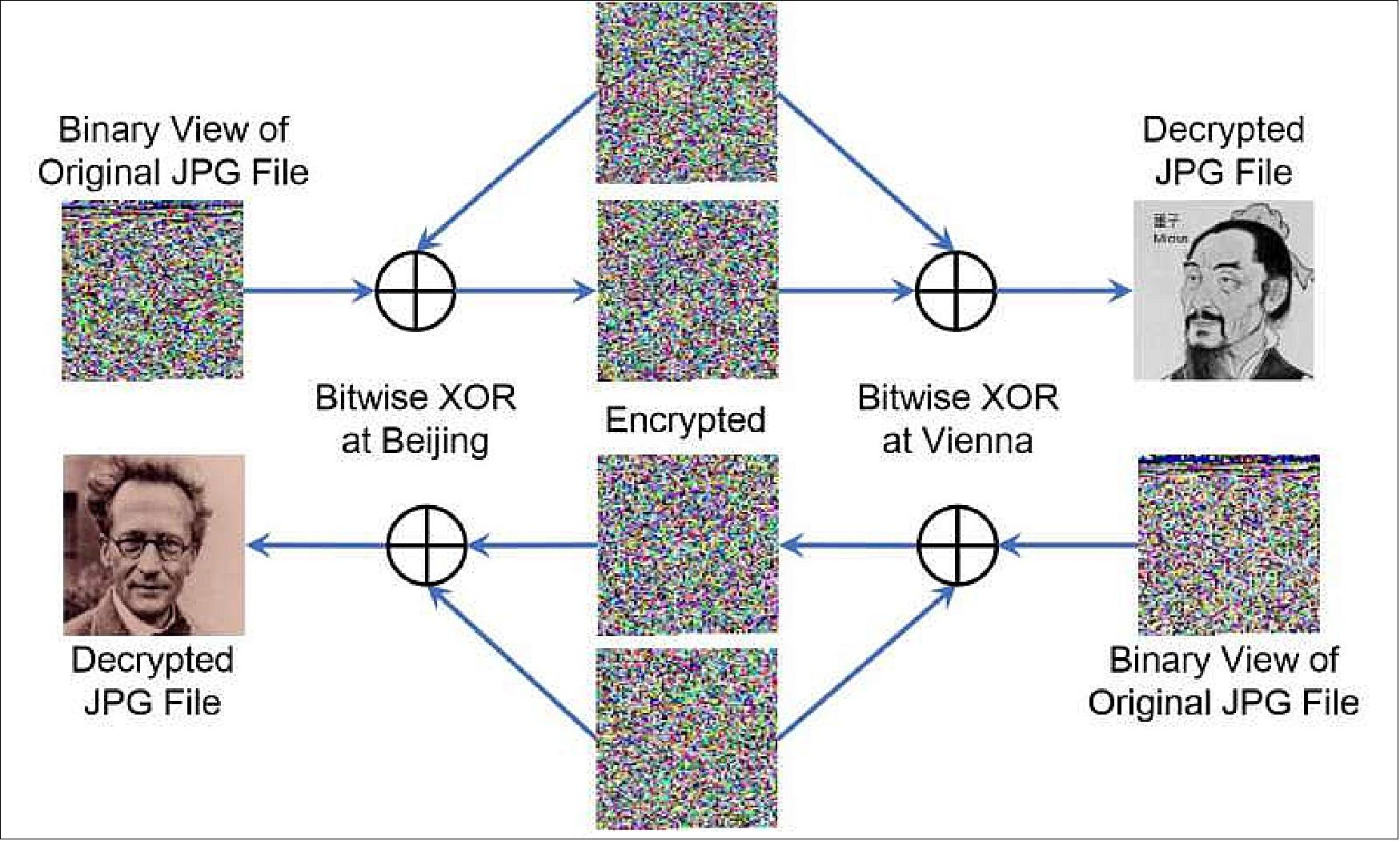
- An intercontinental videoconference was also held between the Chinese Academy of Sciences and the Austria Academy of Sciences, employing the Advanced Encryption Standard (AES)-128 protocol that refreshed the 128-bit seed keys every second. The videoconference lasted for 75 min with a total data transmission of ~2 GB, which included ?560 kbit of the quantum key exchanged between Austria and China. The study will be published in Physical Review Letters. 11)

• August 14, 2017: Chinese scientists have become the first to realize quantum key distribution from a satellite to the ground, laying the foundation for building a hack-proof global quantum communication network. 12)
- The achievement based on experiments conducted with the world' s first quantum satellite, QUESS (Quantum Experiments at Space Scale), nicknamed Micius, was published in the authoritative academic journal Nature on Thursday. The Nature reviewers commented that the experiment was an impressive achievement, and constituted a milestone in the field.
- Pan Jianwei, lead scientist of QUESS and an academician of CAS (Chinese Academy of Sciences), said the satellite sent quantum keys to ground stations in Xinglong, in north China's Hebei Province, and Nanshan, near Urumqi, capital of northwest China's Xinjiang Uygur Autonomous Region.
- The communication distance between the satellite and the ground station varies from 645 km to 1,200 km, and the quantum key transmission rate from satellite to ground is up to 20 orders of magnitude more efficient than that expected using an optical fiber of the same length, said Pan.
- When the QUESS/Micius satellite flies over China, it provides an experiment window of about 10 minutes. During that time, the 300 kbit secure key can be generated and sent by the satellite, according to Pan. "That, for instance, can meet the demand of making an absolute safe phone call or transmitting a large amount of bank data," Pan said.
• July 11, 2017: Two teams of researchers in China have advanced the distance that entangled particles can be used to send information, including encryption keys. In their papers, both uploaded to the arXiv preprint sever, the two groups outline their work and suggest their achievement represents an essential step toward the development of a global-scale quantum internet. 13)
- Quantum entanglement is the shared state of two separate particles—what happens to one happens to the other. Scientists have not yet figured out how this occurs, but they have learned how to create entangled particles on demand, typically by firing a laser through a crystal. As physicists learn more about entangled particles, they've designed more experiments to take advantage of their unique properties. One such area of research involves using them to build quantum networks. Such networks would be much faster than anything we have now, and they would also be much more secure because of the nature of entangled particles—disruptions to encryption keys, for example, could be instantly noted, allowing for prevention of hacking. In this new effort, the researchers have extended the entanglement distance of two particles—one on the surface of the Earth and the other in space, courtesy of a satellite. They have also shown that it is possible to send entangled encryption keys from a satellite to an Earth-based receiving station.
- In the first experiment, the research team transferred the properties of an entangled particle housed in a facility in Tibet to its partner, which was beamed to a satellite passing overhead, far surpassing the distance record by other researchers. In this case, the information transfer occurred with photons that were approximately 500 to 1,400 km apart, depending on the location of the satellite.
- In the second experiment, equipment aboard a satellite created a random string of numbers to represent an encryption key. The key was then beamed to an Earth station as part of an entangled photon stream that used polarization as a means of transmission security.
- Abstract to the submitted paper of the research team 14) - An arbitrary unknown quantum state cannot be precisely measured or perfectly replicated. However, quantum teleportation allows faithful transfer of unknown quantum states from one object to another over long distance, without physical travelling of the object itself. Long-distance teleportation has been recognized as a fundamental element in protocols such as large-scale quantum networks and distributed quantum computation. However, the previous teleportation experiments between distant locations were limited to a distance on the order of 100 km, due to photon loss in optical fibres or terrestrial free-space channels. An outstanding open challenge for a global-scale "quantum internet" is to significantly extend the range for teleportation. A promising solution to this problem is exploiting satellite platform and space-based link, which can conveniently connect two remote points on the Earth with greatly reduced channel loss because most of the photons' propagation path is in empty space. Here, we report the first quantum teleportation of independent single-photon qubits from a ground observatory to a low Earth orbit satellite - through an up-link channel - with a distance up to 1400 km. To optimize the link efficiency and overcome the atmospheric turbulence in the uplink, a series of techniques are developed, including a compact ultra-bright source of multi-photon entanglement, narrow beam divergence, high-bandwidth and high-accuracy APT (Acquiring, Pointing, and Tracking). We demonstrate successful quantum teleportation for six input states in mutually unbiased bases with an average fidelity of 0.80±0.01, well above the classical limit. This work establishes the first ground-to-satellite uplink for faithful and ultra-long-distance quantum teleportation, an essential step toward global-scale quantum internet.

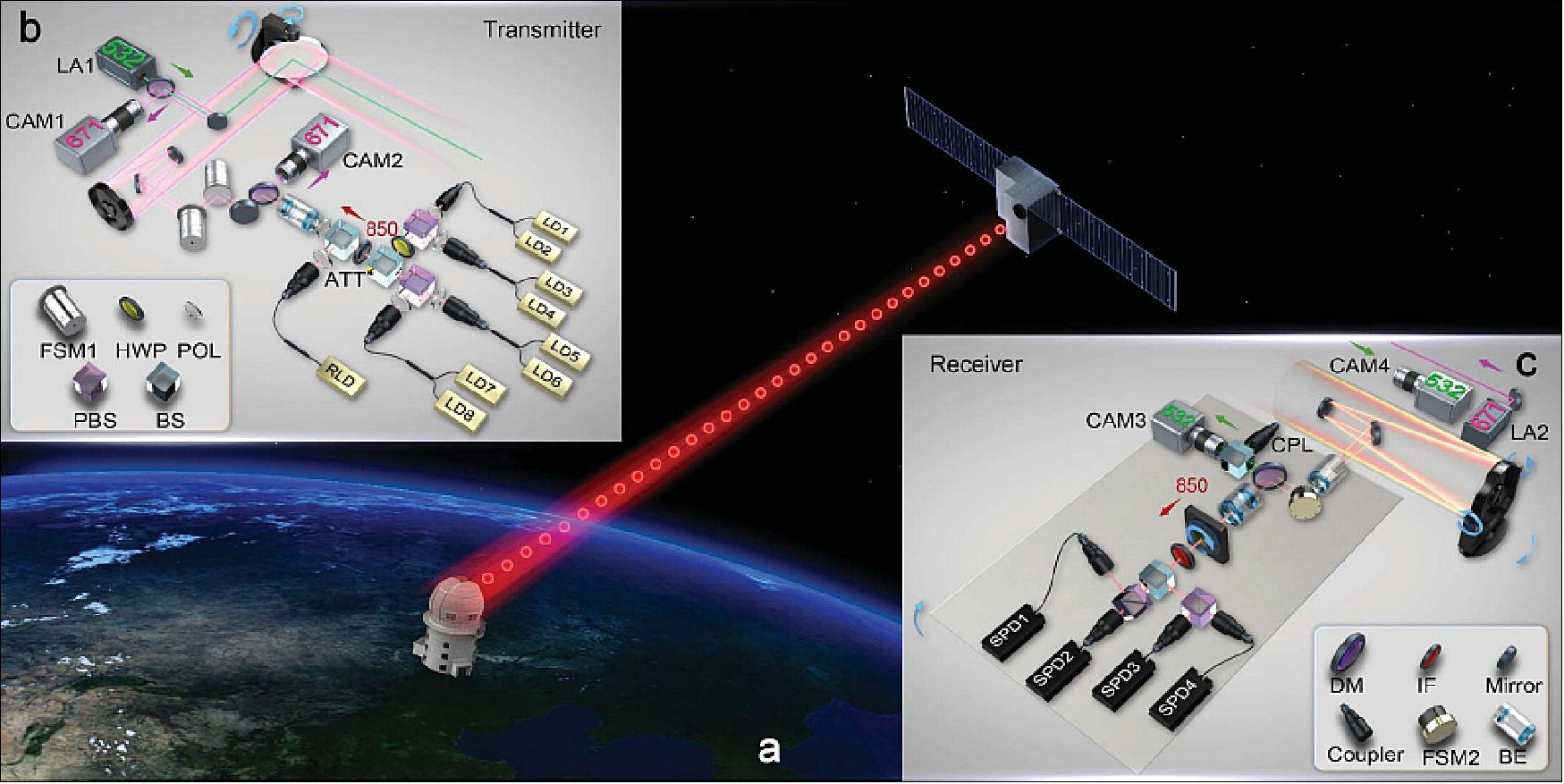
• July 5, 2017: Long-distance entanglement distribution is essential both for foundational tests of quantum physics and scalable quantum networks. Owing to channel loss, however, the previously achieved distance was limited to ~100 km. Here, we demonstrate satellite-based distribution of entangled photon pairs to two locations separated by 1203 km on the Earth, through satellite-to-ground two-downlink with a sum of length that varies from 1600 km to 2400 km. We observe a survival of two-photon entanglement and a violation of Bell inequality by 2.37 ±0.09 under strict Einstein locality conditions. The obtained effective link efficiency at 1200 km in this work is over 12 orders of magnitude higher than the direct bidirectional transmission of the two photons through the best commercial telecommunication fibers with a loss of 0.16 dB/km. 15)
• June 15, 2017: Scientists have used satellite technology for the first time to generate and transmit entangled photons — particles of light — across a record distance of 1,200 km on Earth. 16)
- The feat, published today in the journal Science, is more than 10 times the distance previously achieved using land-based fiber optic technologies. The experiment by a group of Chinese researchers, led by Professor Jian-Wei Pan of the Chinese Academy of Sciences (CAS), takes us a step closer to achieving instant, unhackable communication.
- A cornerstone of quantum physics is a process called entanglement, where the properties of two particles — such as spin, position and momentum — intimately affect each other, even when those particles are separated by large distances.
- "Quantum entanglement was discussed as far back as 1935 by Einstein, Schrödinger and others and it is still extensively studied as a fundamental question, but our knowledge has been restricted by the boundaries that we have been able to explore," said study co-author Professor Chao-Yang Lu.
- "This [experiment] has extended those boundaries by an order of magnitude. Quantum science has also become a new resource as real as energy and is being applied to cryptography, teleportation and quantum computing. This new knowledge can be instantly applied to these areas."
- The editors of that US publication, Science, summarized the news 17): Quantum entanglement has moved out of this world and into space. In a study that shows China’s growing mastery of both the quantum world and space science, a team of physicists reports that it sent eerily intertwined quantum particles from a satellite to ground stations separated by 1200 kilometers. Quantum physics says the quantum states of entangled objects remain linked until one of them is measured. That measurement instantly determines the quantum state of the other, no matter how far away—the “spooky action” at a distance that Albert Einstein was suspicious of. Results from China’s Micius satellite show that the effect is real at a record distance, and the achievement foreshadows other quantum experiments in space.
• January 19, 2017: The QUESS satellite is officially operational after four months of in-orbit testing, according to CAS (Chinese Academy of Sciences) of January 18. The testing of the satellite, payloads and space-ground links have been completed, all systems are operating nominally. The research team has begun to carry out experiments and preliminary data has been obtained, said Jinwei Pan, chief scientist of the project. QUESS will explore "hack-proof" quantum communications by transmitting unhackable keys from space, and provide insight into the strangest phenomenon in quantum physics — quantum entanglement. 18)
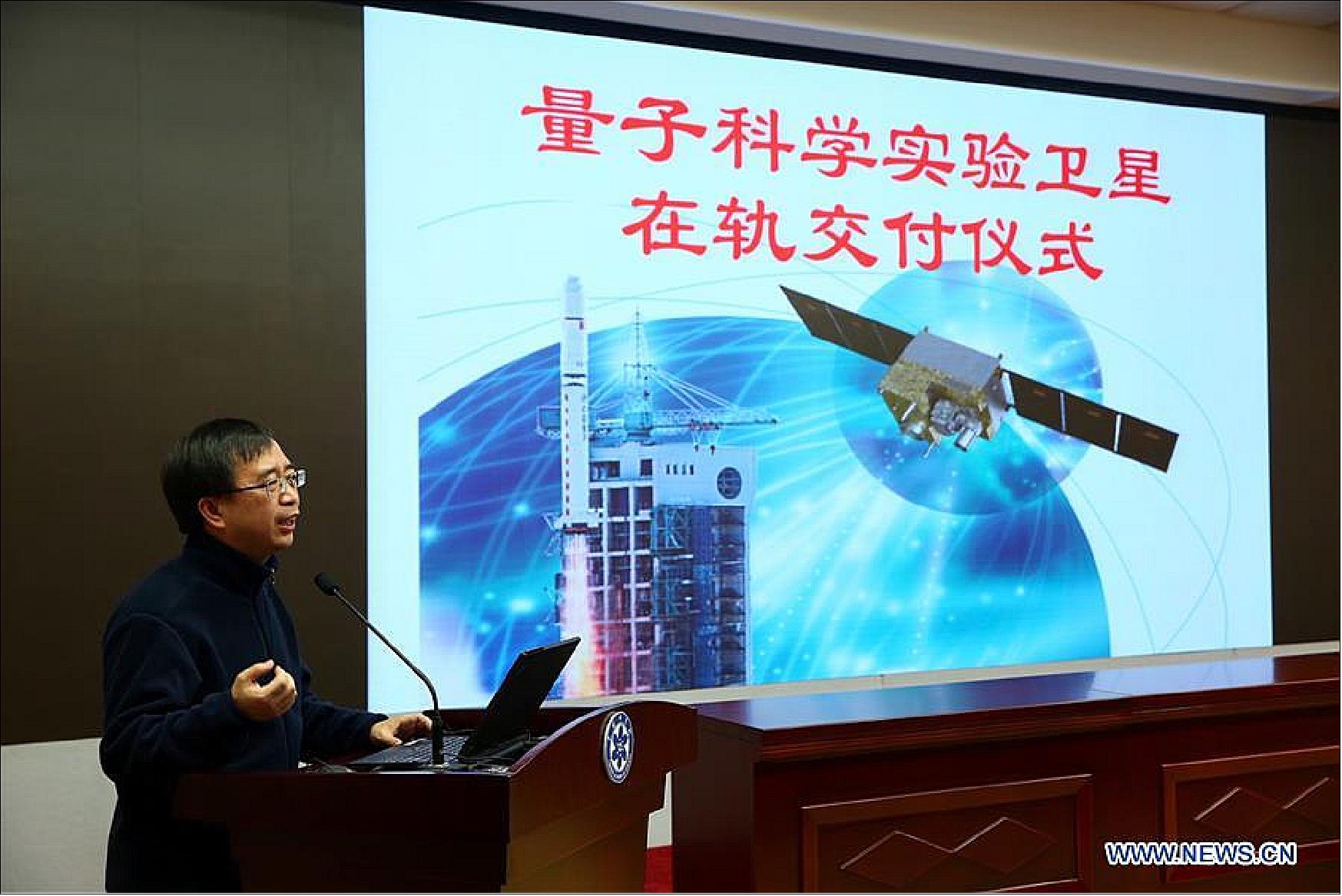
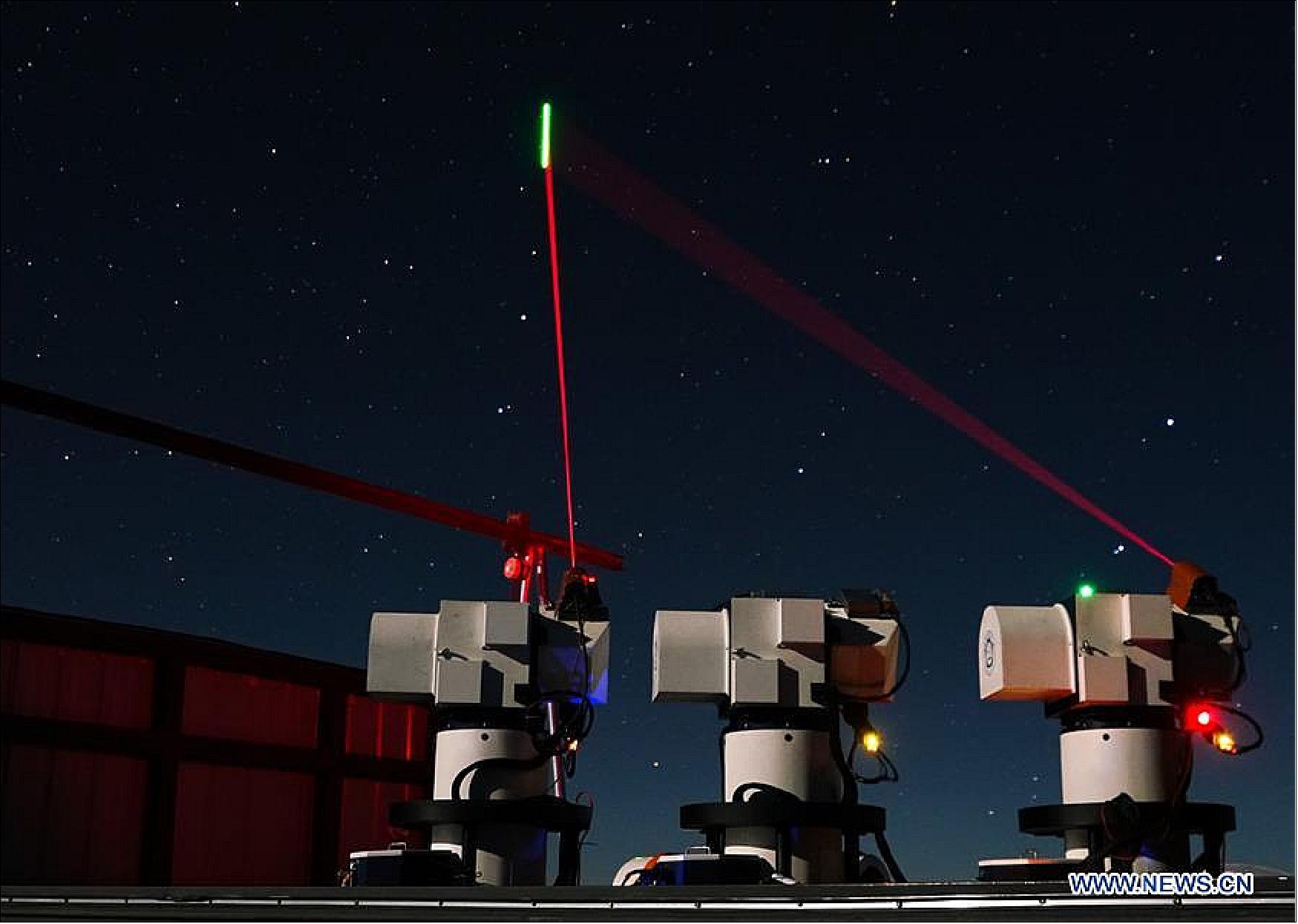
• According to Xinhua, the QUESS satellite transmitted data to the China RSGS (Remote Sensing Satellite Ground Station) in Miyun on the outskirts of Beijing on August 17, 2016. — Two more Chinese ground stations - at Kashgar in the northwest and Sanya in the south - will be involved, as well as a site in Austria. 19)
QUESS first faces a number of technical challenges in orbit, especially to make sure that the receiving telescopes on the ground can precisely track the satellite, which will be travelling at 8 km/s. "It's very challenging to create a perfect quantum channel between the satellite and the ground station," says Jianwei Panfrom the University of the Science and Technology of China, who is QUESS's chief scientist. "We have developed a high-frequency and high-accuracy acquiring, pointing and tracking technique to do that" (Ref. 6).
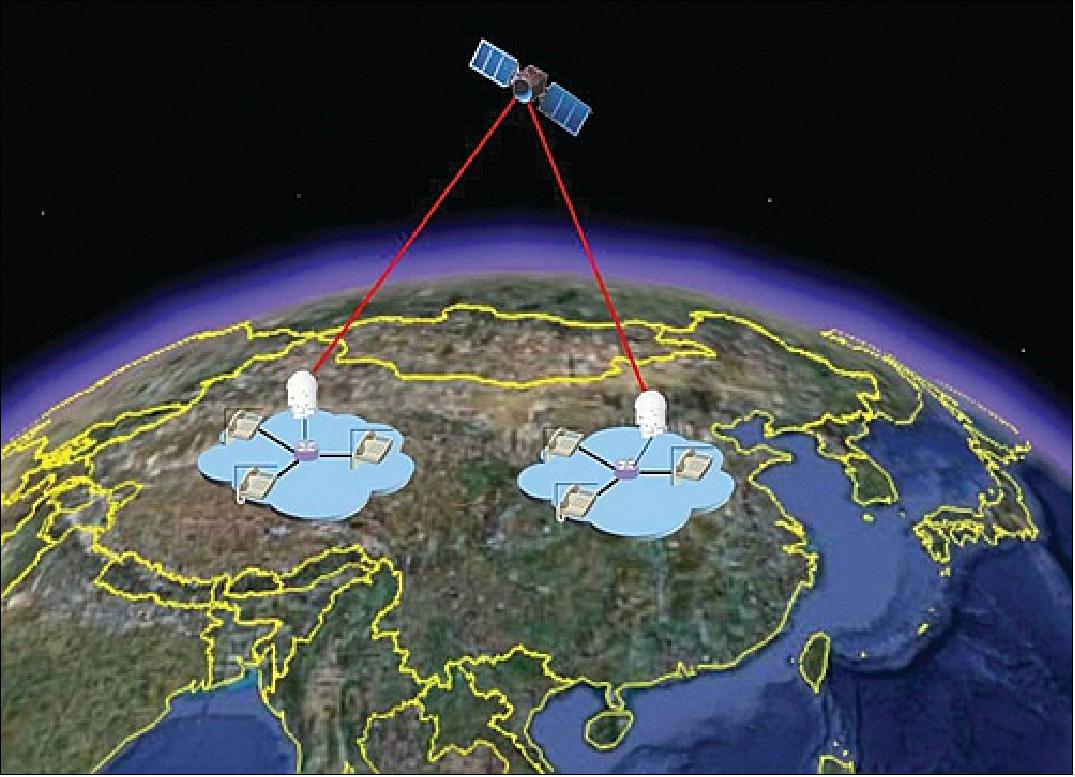
Initial entanglement tests will performed by the Chinese team, according to Jianwei Pan from the University of the Science and Technology of China, who is QUESS's chief scientist. Once these targets have been met, the Chinese team will then collaborate with Anton Zeilinger and colleagues at the University of Vienna to create an "intercontinental" QKD channel between Beijing and Vienna.
Experiment Complement
The overall objective is to test the phenomena of quantum entanglement. The satellite carries four devices, including a quantum key distributor, a quantum entanglement transmitter, a quantum entanglement generator, and a quantum test control processor. It has two separate antennas to simultaneously establish quantum communications with two ground stations on Earth.
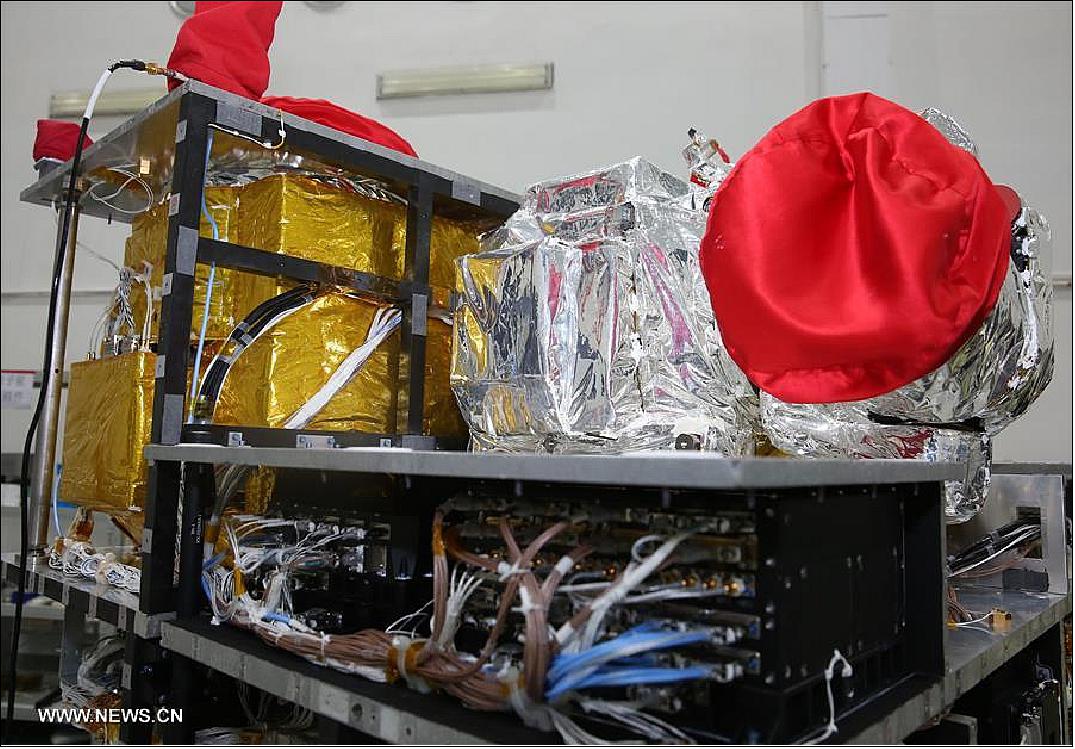
One of the major objectives of the mission is to set a QKD (Quantum Key Distribution) from satellite to ground, setting an ultra-long-range quantum channel between ground and satellite with the assistance of high-precision acquisition, tracking and pointing system, implement a quantum key distribution between the satellite and the ground stations, and carry out unconditional secure quantum communication experiments.
The main instrument on board QUESS is a "Sagnac effect" interferometer. This is a device which generates pairs of entangled photons which can then be transmitted to the ground. This will allow QUESS to perform QKD — the transmission of a secure cryptographic key that can be used to encrypt and decrypt messages — to two ground stations. QKD theoretically offers truly secure communication. In QKD, two parties who want to communicate share a random secret key transmitted using pairs of entangled photons sent with random polarization, with each party receiving one half of the pair. This secret key can then be used as a one-time pad, allowing the two parties to communicate securely through normal channels. Any attempt to eavesdrop on the key will disturb the entangled state in a detectable way. 20)

Note: In reference 23), the experiment complement is designated as: QKT (Quantum Key Transceiver), EDT (Entanglement Distribution Transmitter), EPS (Entangled Photon Source) and ECP (Experimental Control Processor).

Ground Segment
The QUESS ground segment is composed of six parts, include the Chinese Control Center, the Mission Center, the Space Science Data Center, three X-band stations, the Science Center and five ground telescope stations. 23)
![Figure 16: The QUESS ground segment [image credit: NSSC (National Space Science Center), CAS (Chinese Academy of Sciences)]](/api/cms/documents/163813/6202536/QUESS_Auto2.jpeg)
The Chinese Control Center (CCC) which is also be known as the Xi’an Center, manages the satellite in each phase. CCC is in charge of the TT&C of the QUESS, including the uplink of telecommands to the satellite, and downloading the S-band telemetry from the satellite, and determination the satellite orbit parameters. The downloaded S-band telemetry raw data transfers to the MC (Mission Center) in real-time for payload status monitoring. The telecommands for the payload are generated by the Mission Center.
The MC (Mission Center) is responsible for payload operations. The main functions are described as : 1) make mission planning and scheduling, 2) schedule X-band ground stations data reception, 3) payload telecommands management, 4) generate commands for the detectors, PMS, and X-band subsystems, 5) verify command execution, 6) send TC plan (telecommands) to the CCC, 7) receive S-band telemetry data, satellite orbit parameters and attitude data from the CCC, 8) receive the science data from X-band stations, 9) monitor the payload health & status.
The Space Science Data Center (SSDC) is responsible for science data processing, managing, archiving, permanent preservation and distribution of data.
The X-band stations for the mission are: Miyun, Sanya and Kashi stations. They are responsible for scientific satellite tracking, science data reception, raw data recording, formatted outputting, and transferring the data to the Mission Center.
The SC (Science Center) is also known as the Science Application System. The QUESS Science Center proposes a scientific experimental plan, it generates high-level data products, and organizes the research and application functions.
The ground telescope stations include: Xinglong, Nanshan, Delingha, Lijiang, and the Ali stations. They support experiments with the satellite.
Basic Processes
The basic processes of payload operation in the Mission Center are the payload control process and the data real-time processing and monitoring process.
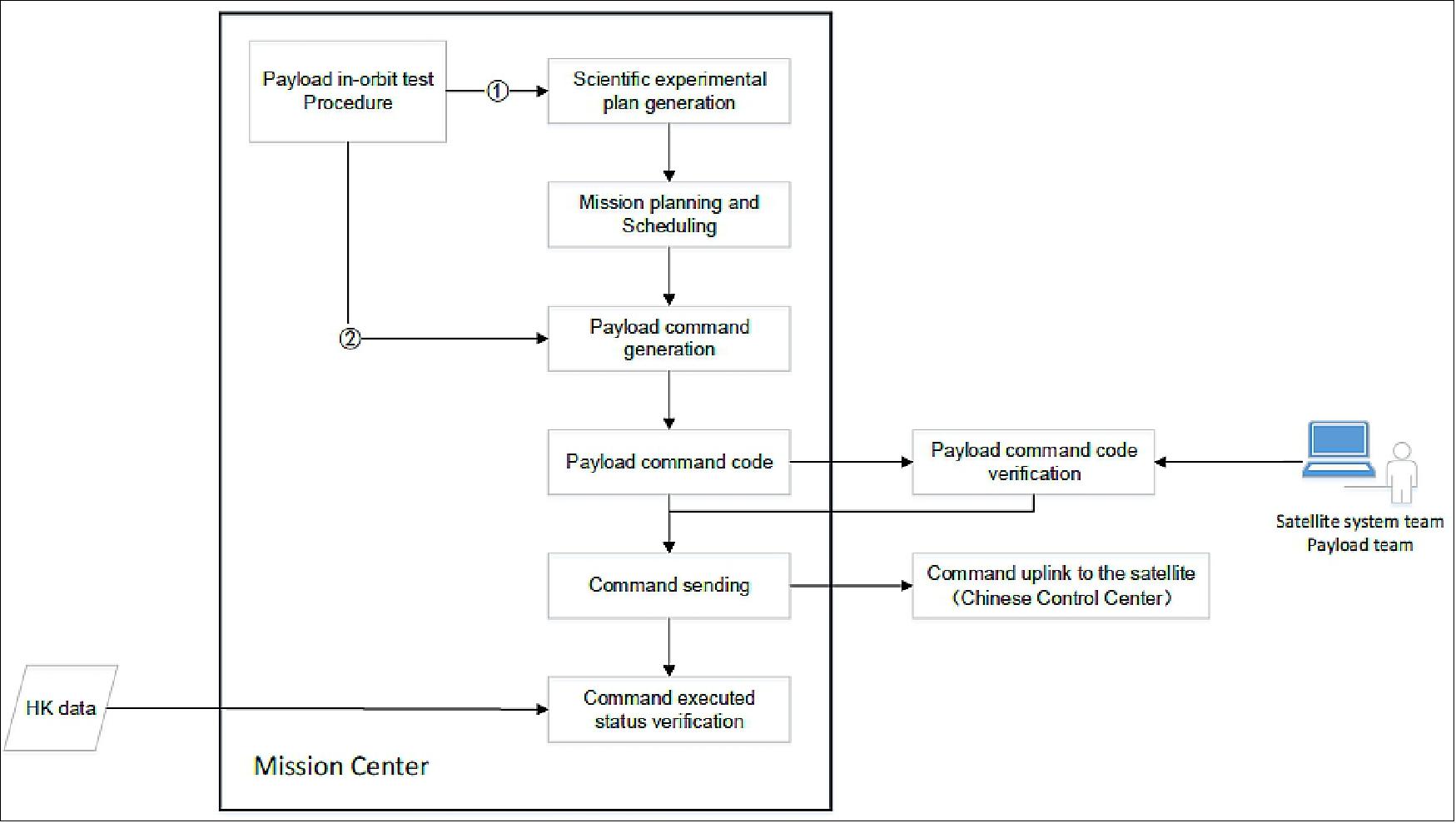
Payload control process: The basic payload control process, shown as Figure 17, gives an overview of the main processes for data reception scheduling, and payload work planning.
In the commissioning phase, the input of the process is “the payload in-orbit test procedure”. There are two ways that can be selected to generate the telecommand for the payload. The first way is creating a scientific exploration plan by the assistant tool, and then making the payload work plan, and from the work plan turn into the payload telecommand automatically. This way is shown as item 1 in Figure 17. The second way is create the payload telecommand using the software manually. This way is shown as item 2 in Figure 17.
Data real-time Processing and Monitoring Process: The basic download data real-time processing and monitoring process can be separated by the different input. One is the X-band telemetry data process, the other is the S-band telemetry data process. For the two inputs the process is almost the same.
The real-time data reception software receives the data, and sends the data to the real-time data process software, and saves the data into a local file for archiving. The real-time data process software receives the data, and decodes the frame, decodes the package, and processes the raw data into the parameter values, distributes the result values to the clients for monitoring the status of payloads by the operational teams in the Mission Center.
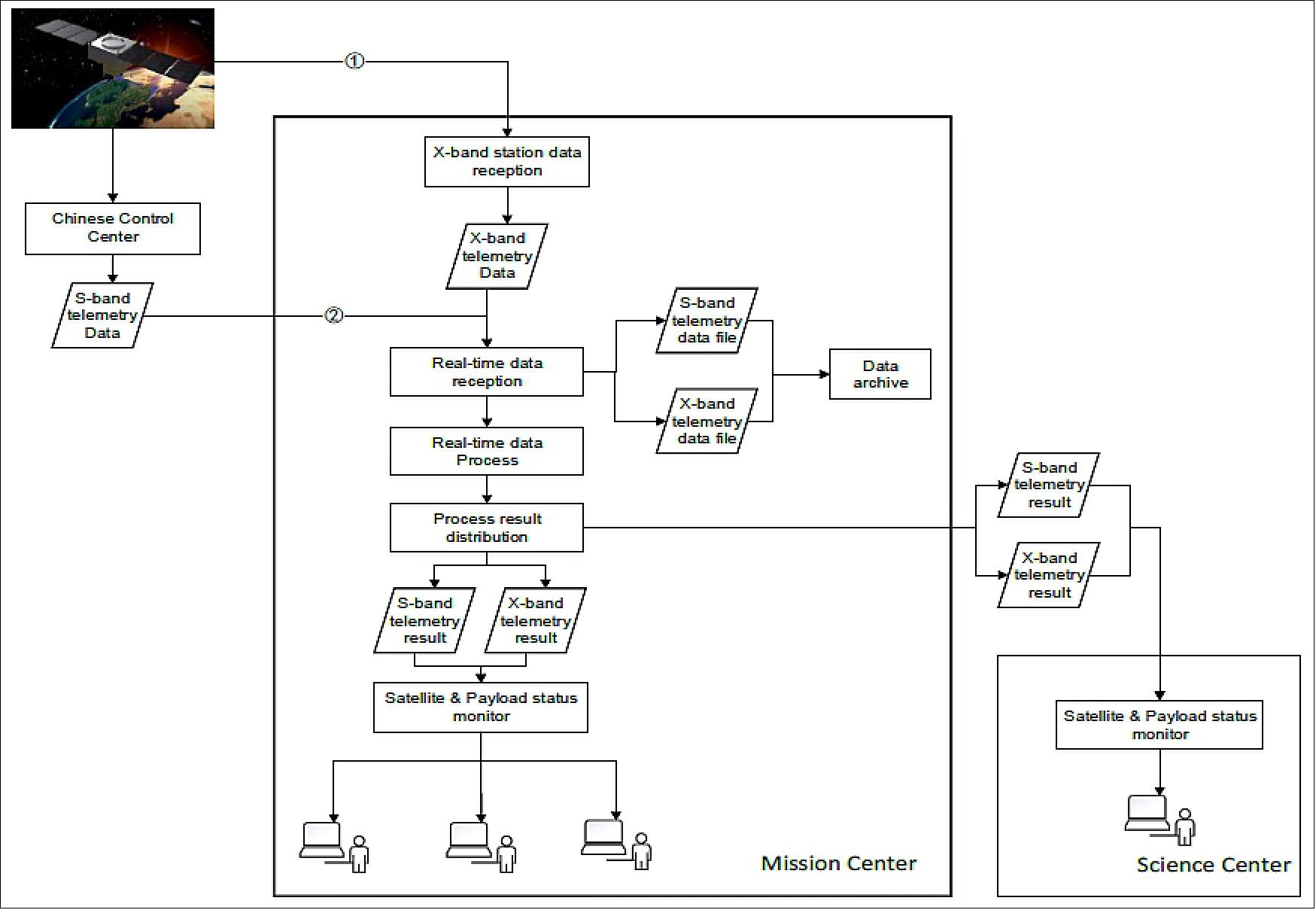
Commissioning Result
After 5 months in-orbit testing, QUESS finished the commissioning successfully. All the payload in-orbit test contents were performed. The satellite and all the payloads are perfectly in good status.
References
1) ”Space quantum communication – cooperation with China,” IQOQI, URL: http://www.iqoqi-vienna.at/home/research-groups/zeilinger-group/space-quantum-communication/
2) ”Vienna Quantum Space Test Link: Milestone in Quantum Communication,” University of Vienna, May 8, 2011, URL: http://medienportal.univie.ac.at/presse/aktuelle-pressemeldungen/detailansicht
/artikel/vienna-quantum-space-test-link-milestone-in-quantum-communication/
3) https://medienportal.univie.ac.at/uploads/media/Bild_2_QUESS_Grafik_c_OEAW.jpg
4) Elizabeth Gibney, ”Chinese satellite is one giant step for the quantum internet,” Nature, Aug. 16, 2016 (updated), URL: http://www.nature.com/news/
chinese-satellite-is-one-giant-step-for-the-quantum-internet-1.20329
5) Tomasz Nowakowski, ”China launches world's first quantum communications satellite into space,” Spaceflight Insider, Aug. 16, 2016, URL: http://www.spaceflightinsider.com/
space-flight-news/china-launches-world-first-quantum-communications-satellite/
6) Ling Xin, ”China launches world's first quantum science satellite,” Physics World, August 16, 2016, URL: http://physicsworld.com/cws/article/
news/2016/aug/16/china-launches-world-s-first-quantum-science-satellite
7) ”First Quantum Satellite successfully launched,” URL: http://tinyurl.com/gtmcglj
8) ”The world's first integrated quantum communication network,” Phys.org news, 6 January 2021, URL: https://phys.org/news/2021-01-world-quantum-network.html
9) Yu-Ao Chen, Qiang Zhang, Teng-Yun Chen, Wen-Qi Cai, Sheng-Kai Liao, Jun Zhang, Kai Chen, Juan Yin, Ji-Gang Ren, Zhu Chen, Sheng-Long Han, Qing Yu, Ken Liang, Fei Zhou, Xiao Yuan, Mei-Sheng Zhao, Tian-Yin Wang, Xiao Jiang, Liang Zhang, Wei-Yue Liu, Yang Li, Qi Shen, Yuan Cao, Chao-Yang Lu, Rong Shu, Jian-Yu Wang, Li, Nai-Le Liu, Feihu Xu, Xiang-Bin Wang, Cheng-Zhi Peng, Jian-Wei Pan, ”An integrated space-to-ground quantum communication network over 4,600 kilometers,” Nature, Published: 6 January, 2021, https://doi.org/10.1038/s41586-020-03093-8
10) ”Real-world intercontinental quantum communications enabled by the Micius satellite,” Phys.Org, 19 Jan. 2018, URL: https://phys.org/news/2018-01-real-world-intercontinental-quantum-enabled-micius.html
11) Sheng-Kai Liao, Wen-Qi Cai, Johannes Handsteiner, Bo Liu, Juan Yin, Liang Zhang, Dominik Rauch, Matthias Fink, Ji-Gang Ren, Wei-Yue Liu, Yang Li, Qi Shen, Yuan Cao, Feng-Zhi Li, Jian-Feng Wang, Yong-Mei Huang, Lei Deng, Tao Xi, Lu Ma, Tai Hu, Li Li, Nai-Le Liu, Franz Koidl, Peiyuan Wang, Yu-Ao Chen, Xiang-Bin Wang, Michael Steindorfer, Georg Kirchner, Chao-Yang Lu, Rong Shu, Rupert Ursin, Thomas Scheidl, Cheng-Zhi Peng, Jian-Yu Wang, Anton Zeilinger, and Jian-Wei Pan, ”Satellite-Relayed Intercontinental Quantum Network,” Physical Review Letters, Vol. 120, 030501 – Published 19 January 2018, DOI:https://journals.aps.org/prl/abstract/10.1103/PhysRevLett.120.030501
12) ”China's satellite sends unbreakable cipher from space,” Space Daily, Aug. 14, 2017, URL: http://www.spacedaily.com/reports/Chinas_satellite_sends_unbreakable_cipher_from_space_999.html
13) Bob Yirka, ”Physicists transmit data via Earth-to-space quantum entanglement,” Phys.org, July 11, 2017, URL: https://phys.org/news/2017-07-physicists-transmit-earth-to-space-quantum-entanglement.html
14) Ji-Gang Ren, Ping Xu, Hai-Lin Yong, Liang Zhang, Sheng-Kai Liao, Juan Yin, Wei-Yue Liu, Wen-Qi Cai, Meng Yang, Li Li, Kui-Xing Yang, Xuan Han, Yong-Qiang Yao, Ji Li, Hai-Yan Wu, Song Wan, Lei Liu, Ding-Quan Liu, Yao-Wu Kuang, Zhi-Ping He, Peng Shang, Cheng Guo, Ru-Hua Zheng, Kai Tian, Zhen-Cai Zhu, Nai-Le Liu, Chao-Yang Lu, Rong Shu, Yu-Ao Chen, Cheng-Zhi Peng, Jian-Yu Wang, Jian-Wei Pan, ”Ground-to-satellite quantum teleportation,” arXiv:1707.00934 [quant-ph], July 4, 2017, URL: https://arxiv.org/ftp/arxiv/papers/1707/1707.00934.pdf
15) Juan Yin, Yuan Cao, Yu-Huai Li, Sheng-Kai Liao, Liang Zhang, Ji-Gang Ren, Wen-Qi Cai, Wei-Yue Liu, Bo Li, Hui Dai, Guang-Bing Li, Qi-Ming Lu, Yun-Hong Gong, Yu Xu, Shuang-Lin Li, Feng-Zhi Li, Ya-Yun Yin, Zi-Qing Jiang, Ming Li, Jian-Jun Jia, Ge Ren, Dong He, Yi-Lin Zhou, Xiao-Xiang Zhang, Na Wang, Xiang Chang, Zhen-Cai Zhu, Nai-Le Liu, Yu-Ao Chen, Chao-Yang Lu, Rong Shu, Cheng-Zhi Peng, Jian-Yu Wang, Jian-Wei Pan, ”Satellite-Based Entanglement Distribution Over 1200 kilometers,” Science, Vol. 356, pp: 1140-1144, 2017, doi: 10.1126/science.aan3211, URL: https://arxiv.org/ftp/arxiv/papers/1707/1707.01339.pdf
16) Annabel McGilvray, ”Chinese scientists use satellite to smash quantum entanglement distance record,” ABC Science, June 15, 2017, URL: http://www.abc.net.au/news/science
/2017-06-16/chinese-satellite-breaks-quantum-entanglement-distance-record/8620240
17) Steven T. Corneliussen , ”China’s achievement with quantum satellite challenges reporters,” Physics Today, June 27, 2017, URL: http://tinyurl.com/swsardm
18) ”China's quantum communication satellite delivered for use,” Xinhua, Jan. 18, 2017, URL: http://news.xinhuanet.com/english/2017-01/18/c_135994394.htm
19) Chunyang Ding, ”China Launches World’s First Quantum Telecommunication Satellite,” Sept. 11, 2016, URL: http://www.yalescientific.org/2016/09/
china-launches-worlds-first-quantum-telecommunication-satellite/
20) Jeffrey Lin, P.W. Singer, John Costello, ”China's Quantum Satellite Could Change Cryptography Forever — QUESS could hold the key to uncrackable communications,” Popular Science, March 3, 2016, URL: http://www.popsci.com/chinas-quantum-satellite-could-change-cryptography-forever
21) ”China's Pioneering Quantum Satellite Launch Slips to August,” CAS, June 23, 2016, URL: http://english.cas.cn/newsroom/news/201606/t20160623_164768.shtml
22) Devin Coldewey, ”China launches the first quantum communications satellite – and what is that, exactly?,” Aug. 16, 2016, URL: https://techcrunch.com/2016/08/16/
china-launches-the-first-quantum-communications-satellite-and-what-is-that-exactly/
23) Ju SU, Yurong LIU, Tai HU, ”QUESS Operations at Chinese Space Science Mission Center,” Proceedings of the 15th International Conference on Space Operations (SpaceOps), Marseille, France, May 28-June 1, 2018, paper:AIAA 2018-2329, URL: https://arc.aiaa.org/doi/pdf/10.2514/6.2018-2329
The information compiled and edited in this article was provided by Herbert J. Kramer from his documentation of: ”Observation of the Earth and Its Environment: Survey of Missions and Sensors” (Springer Verlag) as well as many other sources after the publication of the 4th edition in 2002. - Comments and corrections to this article are always welcome for further updates (eoportal@symbios.space).
Spacecraft Launch Mission Status Experiment complement Ground Segment References Back to Top